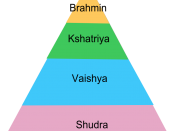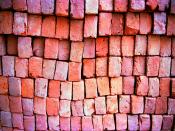The Indian word for caste is jati, which means a large kin-community or descent-group. The word "caste" comes from the Portuguese casta (breed or race). The Sanskrit word applied to these groupings is varna, which means several things but is often interpreted to signify color. In a verse from the first millennium epic, the Mahabharata, Brigu, the sage explains: "The brahmans are fair, the ksatriyas are reddish, the vaisyas yellow and the sudras are black" (Huttton). In this essay I look at how the caste system existed in ancient India and how it currently exists in modern India. I will also try and explain how the caste system has evolved from its ancient ways and how it currently functions in modern India: for example, what sort of role it plays in India's politics and in government policies. I will also give my personal opinion on the Indian caste system.
Of the many cultures that flourished in India the literary records of the Indo-Aryan culture are not only the earliest but contain the first mention of the components of the ancient Indian caste. The Indo-Aryan, when they entered India, considered themselves more advanced and more developed than the native aborigines of India. When they (Aryans) came they had mainly three well-defined classes amongst themselves, intermarriage between which must have been rather rare, though not forbidden. These three classes to a great extent worked and functioned the way the caste system functioned but the differences between the three classes was not all that rigidly marked. (Bashm).
When the Aryans entered India their first task was to exclude the sudras, a class largely composed of the aborigines, from their (Aryan) religious worship. The lowest caste of the Indian society represented the sudras at that time. The sudras were not allowed to practice...


